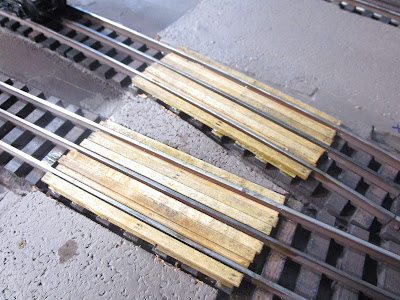Then, planks cut from some 1/8" x 3x16" basswood were glued on. I pressed them snuggly against the middle rail because no wheel flange rides along there. But, I had to leave a gap along the insides of the outer rails to account for oversize tinplate flanges.
The passing siding has a slight curve to it, and I used T-pins to hold the wood securely in a slight curve until the wood glue cured. I did each board one at a time so that I could put as much clamping pressure as possible on it.
Then, very thin wood was glued into the gaps on the insides of the running rails where the flanges go. They aren't high enough to match up with the other boards, but they hide the ballast and gaps between the ties. I tested with a boxcar to make sure there weren't any clearance issues.
A 0.5mm mechanical pencil was used to punch holes in the boards to represent nails. An awl would have worked just as well. This pencil is part of a set given to me by my model mentor who bought them for the exact same purpose.
I had recently made some new batches of ink and alcohol stains so I first treated the wood with a reddish-brown wash. Then, I went over it several times with a weak black wash to add weathering.
They are now ready for the dirt and gravel road.







No comments:
Post a Comment